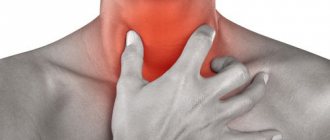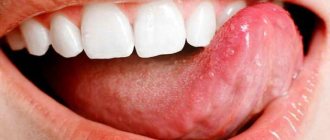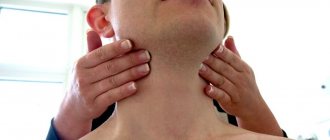A patient complaining that his neck hurts in front under the chin is not such a rare case in the practice of modern doctors. Patients themselves, faced with unpleasant or painful sensations in the throat area, often begin to panic and draw terrible pictures of possible ailments. The difficulty is that not every person is familiar with the structure of the neck in detail and has no idea what systems located inside this part of the body can fail and lead to pain.
Pain under the jaw: what causes unpleasant symptoms and how to eliminate them
If you have pain under your jaw, you should not ignore the unpleasant symptoms. They can talk about a number of diseases, some of which pose a serious danger to the body. Pain can also be caused by mechanical stress. When a blow occurs, you should ensure the integrity of the jaw. In any case, you need to visit a doctor. You may need to consult a dentist, surgeon, neurologist, otolaryngologist, or others. To understand which doctor is needed, it is worth analyzing the nature and location of the pain.
Benign tumor, or lipoma
A lump has appeared under your jaw on the right or maybe on the left, and you are wondering what it is? One of the most common reasons for its appearance is a large wen. To the touch, the formation is soft, motionless and painless. A small lipoma does not pose a serious threat to the body, but if it is not removed, it will continue to grow. The tumor, reaching 5–10 cm in diameter, compresses the nerve endings, disrupts blood circulation and normal cell nutrition. In addition, a large wen is an aesthetic problem, as it spoils the appearance of the face.
A small lipoma does not pose a serious threat
Under unfavorable factors (internal diseases of the body), a lipoma can degenerate into a malignant tumor.
What could be the cause of the discomfort?
Pain under the jaw can occur on the left and right, with pressure or at rest. It can be provoked by many reasons - dental diseases, bruises, damage to nerve endings, etc. Among the most common causative factors are:
- Bruxism (teeth grinding). In some people, the anomaly manifests itself during nervous tension. But more often this disorder occurs in a dream, so a person does not even suspect that he is suffering from bruxism. In addition to wearing away tooth enamel, it can cause jaw pain.
- Dental diseases: deep caries, pulpitis, periodontitis, sialolithiasis (salivary stone pathology). More often, painful sensations appear when an infection affects the pulp. Microorganisms spread along the root canal and infect nearby tissues. This explains why my jaw hurts.
- Osteomyelitis. When the disease occurs, the infection spreads throughout the body through the bloodstream, affecting bone and soft tissue. If osteomyelitis of the jaw develops, the temporomandibular joint (TMJ) is often involved in the painful process. In this case, in addition to painful sensations, the temperature rises and the face swells.
- Neurological and vascular pathologies - for example, neuralgia, dysfunction of the heart vessels. With arteritis, when the facial artery is affected, pain begins in both jaws. The end point of the painful arc is the corner of the eye. With neuralgia of the glossopharyngeal nerve, there is severe pain under the chin when pressed or at rest. The main reason for the development of pathology is hypothermia and viral infections.
- Fracture. Possible with strong impact on the jaw. In this case, acute pain is felt, the face swells, and hemorrhage is observed. With a fracture, chewing is difficult or even impossible.
A child’s chin may hurt during the period of changing teeth. This is explained by the fact that as they grow, the nerve is pinched, which provokes unpleasant sensations. Attacks can last from a few minutes to an hour. To rule out various diseases, the child should be shown to other specialists. Difficulty cutting through the figure eight in adults can also cause a sore throat that radiates to the jaw. Pain is considered normal even after tooth extraction, especially the third molar, if it does not increase and unpleasant symptoms do not persist for more than 7 days. Otherwise, you need to consult a doctor.
Wearing orthodontic appliances also causes some discomfort. So, when using a braces system, the arch, acting on the teeth, promotes their movement. The roots put pressure on the bone tissue, which provokes a dull aching pain in the jaws at first. It happens that painful sensations are caused by excessive tension of the arch. For the unpleasant symptoms to disappear, you only need to weaken it.
Sialadenitis
Salivary stone disease, or sialadenitis, appears due to blockage and inflammation of the salivary glands. The disease most often occurs in the submandibular and parotid areas1. Pathology develops mainly on one side of the jaw. Patients who consult a doctor with this problem complain of swelling under the jaw, chin, or near the ears. In the initial stages, the cheek and neck swell; in later stages, pain occurs when opening the mouth, talking, chewing and swallowing food.
The cause of the lump may be salivary stone disease
Sialadenitis can worsen and recur from 2 to 6 times a year. Dysfunction of the salivary glands and hyposalivation (lack of saliva) contribute to various infectious processes in the oral cavity. The most common is generalized periodontitis, due to which you can lose all your teeth.
“The other day, quite unexpectedly, a lumpy lump appeared under my chin, I went for an ultrasound, and there I was stunned by the news that these were stones in the salivary ducts. There were no other symptoms before. As treatment, they prescribed all sorts of pills and physical procedures, massage, but if it didn’t help, they said that they would put them in surgery and cut them up...”
Flo, review from 32top.ru
Lymphatic changes as one of the causes of pain under the jaw
When discomfort occurs, it is first necessary to assess the health of the submandibular lymph nodes. It is worth excluding or confirming (if pathology is present) lymphadenitis - inflammation that develops when an infection enters the lymph nodes. The disease in its acute form is accompanied by severe pain, body temperature rises, and weakness appears. Discomfort is especially acute when pressing on a sore spot. If timely treatment is not carried out, the disease enters the chronic stage. With different forms of lymphadenitis, an abscess or phlegmon can develop - a purulent formation.
Lymph nodes can become inflamed, for example, in acute and chronic tonsillitis. In this case, it can hurt from different sides under the jaw. But other symptoms come to the fore: acute pain in the throat (especially when swallowing), purulent plaque on the tonsils, fever - even up to 40˚C.
If the lymph node in the neck hurts, this may also indicate the appearance of a neoplasm. More often these are metastases that penetrate from other organs. The nature of the pain varies. The patient has an elevated body temperature for a long time, weakness appears, and he sharply loses weight.
Atheroma of the sebaceous gland
A tumor resulting from blockage of the sebaceous glands is called atheroma or sebaceous cyst. Most often it occurs where there are a lot of sebaceous glands - on the head or face (mainly below the level of the mouth, under the jaw). Soft to the touch, mobile, painless. The lump under the jaw on the right or left increases in size very slowly and usually does not exceed 40 mm in diameter.
Atheroma most often occurs where there are many sebaceous glands
The bad thing is that atheromas often fester. They can communicate with the surface of the skin - in this case, a cheesy mass can seep out through the hole, which smells unpleasant. To avoid such unpleasant consequences, atheroma, like all neoplasms, is removed surgically.
The nature of pain depending on the type of disease
Since various diseases can provoke discomfort, its nature will differ:
- Arthrosis. There is a constant aching pain. It is also accompanied by a crunch. If you open your mouth too much (or while chewing), the pain increases. In most cases, attacks occur in the morning.
- Migraine. With this neurological disease, pain is usually felt in the neck under the jaw on one side. It intensifies when exposed to irritants - bright light, sudden changes in lighting, loud sounds, strong odors. Other characteristic symptoms include thirst, nausea, spots in the eyes, and speech disorders. The duration of attacks is from 3 hours to 4 days.
- Angina. The disease is accompanied by pain under the jaw and in the throat. It intensifies when swallowing. Often the patient even refuses food. Painful sensations can also be felt in the ear.
- TMJ dysfunction. With pathology, pain appears in the lower jaw, in front of the ear, in the forehead and cheeks. Characteristic “clicking” sounds may occur. Sometimes there may even be a “jamming” of the jaw. The pain is characterized as prolonged, dull, muffled, becoming more acute when opening the mouth wide or chewing.
- Neuralgia of the ear node. The pain manifests itself in attacks that can last up to an hour. It radiates to the lower jaw and temple. Strengthens when pressed. The person may feel a "clicking" sensation in the ear.
- Benign tumors. In the initial stages of the disease, the patient does not notice any symptoms. Sharp pain with osteoid osteoma is felt already in advanced disease. Osteoblastoclastoma is accompanied by aching pain in the jaw. The temperature may also rise, and a pale pink growth appears on the gums. Late forms of adamantioma are characterized by sharp pain in the jaw, the intensity of which increases with chewing.
- Malignant tumors. At first, the pain is practically not felt, but after a while it will be impossible to live normally without analgesics. So, with osteogenic sarcoma, which develops in bone tissue, the pain is very strong. The attacks are prolonged.
Sharp and severe pain in the chin in some cases is the first sign of myocardial infarction and angina. The localization of unpleasant symptoms in this case is often on the left.
Prevention
A variety of preventive measures will help prevent the disease from exacerbating and returning. First of all, it is maintaining a healthy lifestyle. Engage in moderate physical activity and avoid eating unhealthy foods in excess. If you periodically have pain in your neck under your chin, then do not forget to visit a doctor and consult with him before you feel another pain syndrome. Stop smoking or reduce the number of cigarettes you smoke per day. Try not to abuse alcohol or take medications not directly prescribed by your doctor.
Diagnosis of diseases
Even if the pain is mild at first, over time it can develop into exhaustion. Therefore, do not hesitate to visit a doctor. He will conduct an examination, collect anamnesis, prescribe x-rays and tests. For heart problems, an ECG is additionally performed. If a tumor is suspected, the examination will be more serious, since it is necessary to determine what kind of tumor (benign or malignant), the stage of the lesion, and the presence of metastases.
Taking painkillers can “blur” the clinical picture, so you should not use them without a doctor’s prescription, especially before diagnosis. Only with a correct diagnosis will the doctor be able to determine what to do to eliminate the pathology.
Internal subcutaneous pimple or boil
If there is a small lump under the jaw on the left or right, then this may well be an ordinary subcutaneous pimple. Many people do not think that such a tumor poses a serious threat, but if you start squeezing the pimple, the infection can go inside the body, and you will end up on the surgical table. Moreover, if such pimples appear frequently and do not go away for a long time, then this signals problems with the internal organs, excretory, reproductive and endocrine systems.
The photo shows a boil under the jaw
Do not under any circumstances try to crush, puncture or heat the lumps under the jaw. You can bring an infection inside, cause complications and the appearance of rashes in new places.
Basic methods of treating pathologies
Analgesics will only hide the symptoms for a while, but will not solve the problem. Therefore, it is necessary to treat the disease that causes pain. Let's give some examples.
Jaw injuries
If you are bruised, you should immediately apply a cold compress and bandage to the sore spot. You should definitely see a doctor to rule out other serious pathologies, such as a dislocation or fracture. During treatment, it is important to ensure complete rest for the jaw.
If the cause of pain is a dislocation, the jaw is set into the correct position and fixed with a bandage, which helps ensure its immobility. In case of a fracture, the traumatologist performs splinting or intermaxillary fixation. If it is open, the technique of osteosynthesis with titanium plates is used.
Treatment of osteomyelitis
The tooth involved in the painful process will have to be removed. When performing manipulations, the doctor in most cases opens a purulent focus in the bone and adjacent tissues. Incisions can be made either intraorally or extraorally. All actions are carried out under local anesthesia. After surgery, it is important to carefully clean the wounds. The doctor prescribes antibiotics, vitamins, painkillers and other necessary medications.
With bone necrosis, the doctor determines how to treat osteomyelitis based on the stage of the inflammatory process.
Treatment of TMJ dysfunction
Pathology therapy involves an integrated approach:
- the use of orthodontic techniques that involve correcting the bite;
- operation;
- “remaking” teeth or prosthetics;
- physiotherapy and acupuncture.
Treatment of sore throat
The doctor determines the treatment method depending on the degree of the disease. More often, the patient is treated at home under the supervision of a specialist. The doctor prescribes antipyretic and antiviral drugs, as well as remedies for sore throat.
Using any folk remedies without traditional treatment is a big health risk. They can only be used in some cases as an auxiliary therapy, after consulting with your doctor.
Each case is individual, and the treatment method for one patient may not help another. Therefore, in any case, it is worth contacting a specialist - a dentist or therapist, for example, and if necessary, he will refer you to another doctor.
Comments
I suffered from a severe sore throat, after which two lumps appeared under the jaw on the right, the doctor said that these were lymph nodes and prescribed ointments, but nothing helped. I don’t know what to do anymore.
Mikheeva (05/01/2020 at 18:44) Reply to comment
- Enlarged lymph nodes indicate the presence of an infectious-inflammatory process in the acute or chronic stage. It is necessary to conduct a detailed diagnosis of your condition, for this you need to take smears for flora, take a detailed blood test, visit an ENT doctor and a dentist.
Editorial staff of the portal UltraSmile.ru (05/14/2020 at 09:14) Reply to comment
I have a lump on the left side opposite the corner of my mouth. It doesn’t hurt, nothing hurts, when I press on it, it’s hard. It’s been 2 weeks now and it hasn’t grown or fallen, I feel like always, I don’t have a fever, but I have lower dentures. .What is this?
Tatyana (07/04/2020 at 06:35) Reply to comment
A lump appeared 3 years ago under the jaw in the area of the lymph node and it seems that it is a single whole because... the node lost its mobility when palpated, they took a picture, a lump (1-2 cm) is visible in the picture, they said the problem was teeth, removed the problematic one, the lump remained, but did not progress, did not hurt, but when moving the neck there was an unpleasant sensation sometimes behind the ear too, an oncologist at the local he told the clinic that he wasn’t seeing anything, maybe he’d contact the oncology center, but they didn’t prescribe treatment
Alexey (09.24.2020 at 15:51) Reply to comment
He bit the same spot on his lip twice. It became swollen and there was pain on the lower side of the jaw (the lip hardly hurts), pain when moving the jaw, but not when swallowing. A small lump is felt on the bottom of the bone, which is very painful when touched.
Georgy (07.10.2020 at 19:42) Reply to comment
Write your comment Cancel reply
Symptoms
If unpleasant sensations rarely bother you, they may be the result of an uncomfortable sleeping position or awkward head movement. No special treatment is required. To eliminate discomfort, do exercises, light rubbing, take warm baths, it is recommended to use an orthopedic mattress and pillows. But there are situations when you urgently need a consultation with a neurologist or chiropractor.
Warning signs include:
- stiffness of movements;
- the duration of painful sensations is more than 1-2 days;
- the appearance of concomitant pain in the shoulder, arm;
- frequent headaches, especially in the back of the head, which are accompanied by dizziness;
- numbness of fingers, hands.
If you have suffered a neck, head or spine injury and are constantly experiencing pain in these areas, we invite you to contact our Innovative Medical Center for help.
Back neck pain
Changes in the spine are the main cause of aching, sharp or nagging pain in the neck area. They occur due to low physical activity and constant work at the computer. Discomfort can be a symptom of the following diseases:
- osteochondrosis - changes in the structure of intervertebral discs;
- protrusion of intervertebral discs (their protrusion);
- intervertebral hernia;
- spondylosis - bone growths on the vertebrae;
- muscle spasms;
- vertebral fractures as a result of whiplash injuries or osteoporosis.
Pain in the back of the neck is a non-standard symptom of spinal tuberculosis, osteomyelitis, and Reiter's syndrome.










